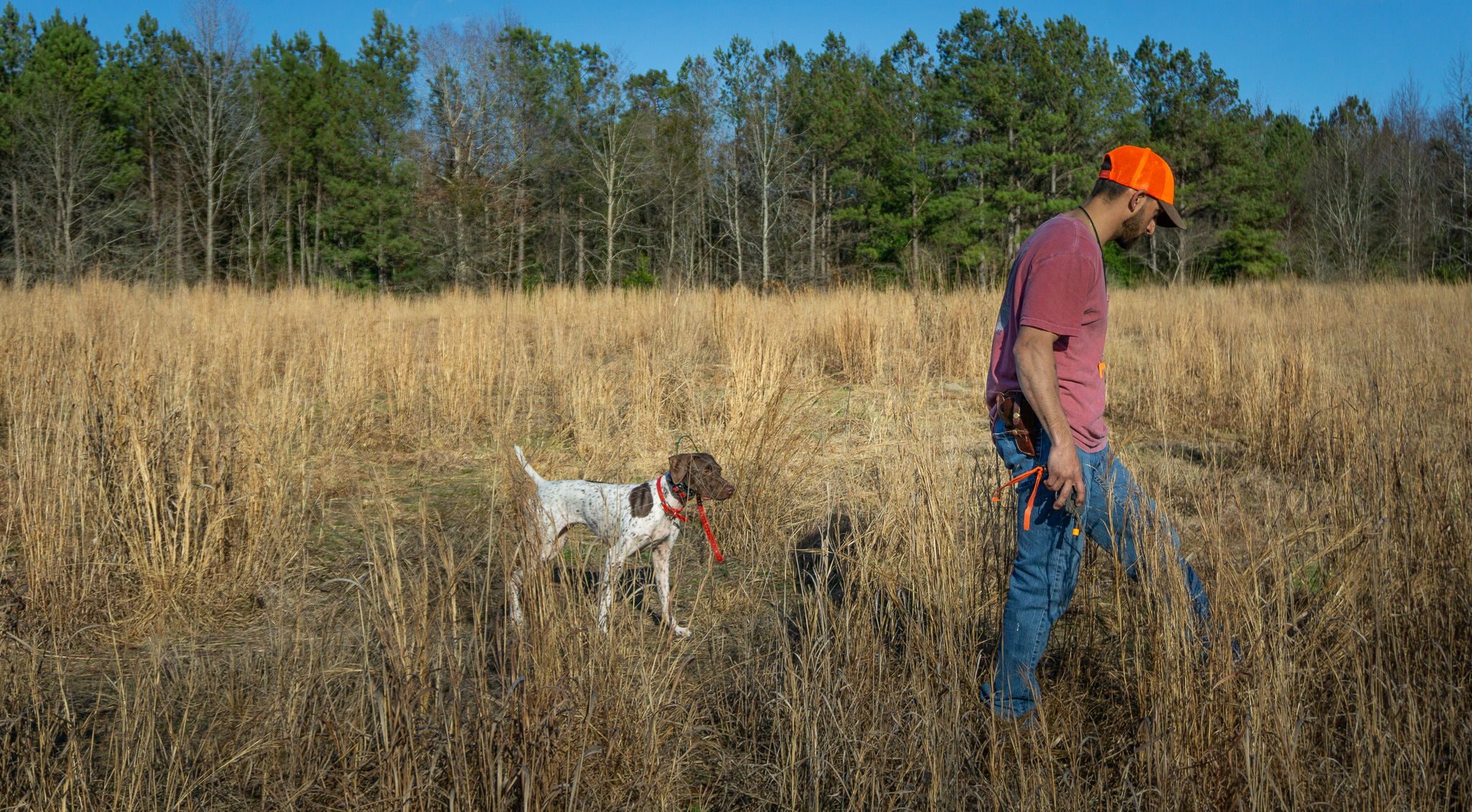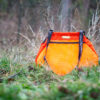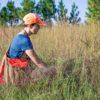Are you interested in learning how to start hunting with your bird dog? Do you have a young, energy-filled pointer, German shorthair, vizsla, Brittany, etc. and you’re curious about hunt tests or field trials? It can be confusing when you first get started, especially if you are new to bird hunting or bird hunting games. Where do I begin? How do I find someone to help me? What if I have never shot a gun before or my dog is not a puppy or I live in a city?
I know entering the hunting and testing world can be downright overwhelming at times, because I was in that same boat several years ago. Hopefully this post will help point you in the right direction. This is not a step-by-step plan, but some general ideas to get you started.
Attend a Hunting Competition or Event
If you’re interested in learning more about hunt tests or field trials, I recommend finding a local event or two to go to. You’ll understand these activities so much better by seeing them in person. American Kennel Club (AKC) hunt tests and field trials can be located on the AKC website or by using the event search tool Perfdog. If you find an event that interests you, reach out to the test or trial secretary and tell them that you’d like to come watch. Most people will be happy to have a new person and will provide the relevant information about when to arrive, where to park, etc.
There’s plenty of other organizations that hold tests and trials (I will be covering many of these on future episodes of my podcast!).
- North American Versatile Hunting Dog Association (NAVHDA) – holds standards-based tests. Most chapters have tests once or twice a year, and spectators are usually welcome. Email the appropriate test secretary listed on the test calendar page to find out more information about a specific test.
- United Kennel Club (UKC) – field trials that allow for placements and passes. The UKC club near me holds family-friendly events and the trials are all walking, which is great for newbies.
- American Field – field trials, usually horseback. I’m not as familiar with AF trials, but reach out to the organizer for a local event if you want to attend.
- National Shoot to Retrieve Association (NSTRA) – field trials that are based on a points system. The NSTRA chapter near me has many trials each season and they are very welcoming to new people.
- There are plenty more: United Field Trialers’ Association (UFTA), National Bird Hunters Association (NBHA), etc.!
Expose Your Dog to Birds
If you are brand new to the idea of hunting with your bird dog, then it’s possible that your dog hasn’t had any exposure to pen-raised (human-raised) game birds like quail, chukar, or pheasants. That’s totally fine, and your dog’s age doesn’t matter. While it will certainly be easier to train a young dog than a four, seven, or ten year old dog, just because your dog is older doesn’t mean it can’t learn to hunt.
You’ll want to locate a place that has live game birds where you can safely expose your dogs to birds. Finding a place to do this may require some research. Below are some options.
- NAVHDA – Take a look at NAVHDA’s website and see where the closest chapter is to you. NAVHDA can be a good resource because most chapters have monthly training days that you can attend with your dog. There are many experienced people at these events and even if you have no intention to test in NAVHDA’s system, it can be a great way to meet people and gain the knowledge on how to expose your dog to birds (and gunfire) safely.
- HerUpland – HerUpland is a good option for women looking to get involved in hunting events. HerUpland is a new nonprofit organization whose mission is to provide opportunities for women and girls in upland hunting, bird dog training, conservation, and mentorship. HerUpland is hosting a few Novice Pointing Dog Camps this summer and they would be a great way to get your dog started. There’s also an online member community you can join. While it is a paid membership program, there are plenty of women hunters with bird dogs on the platform spread throughout the country. Joining the appropriate geographic region on there and making a post introducing yourself could help you find a mentor. There’s also a free Facebook group.
- Hunting Preserves – There are likely a few upland hunting preserves in your state. These operations typically sell pen-raised birds that you can purchase and put out in one of their fields for your dog. If you have a young dog that hasn’t been around gunfire, I’d call the preserve and ask when a quiet time would be to visit. That way, there aren’t a bunch of other people around shooting while you’re trying to introduce your dog to birds.
- Buy Birds / DIY – You can visit a bird grower and purchase some quail or chukar to take elsewhere. This might be a good option if you have access to private or public land that allows this sort of thing. Certain states have dog training areas as part of the their wildlife management areas. Maryland is one of them. To find bird growers in your state, try Googling or check out the state map on the Bird Dog Society’s website (scroll to bottom of the page). If you click on your state, there is a list of bird growers.
- Other Options – check out my post (also mentioned below) about how to find a place to train your bird dog. This may give you other suggestions on where you can first introduce your dog to game birds. There are also some good videos online that describe how to go about doing a proper bird intro once you find a place that has birds. Standing Stone Kennels’ YouTube channel has a lot of great videos.

At a field trial or hunt test, you have to flush the bird after your dog goes on point. In an AKC field trial, the judges will be on horseback, as seen here. In an AKC hunt test, they can either be on horseback, riding a ATV/UTV, or walking. Other organizations have different rules about the judges.
Set a Goal
Once you’ve had some exposure to different hunting events, think about what you’d like to do with your dog. While it’s not necessary to have a concrete goal, a general waypoint of where you’d like to head will provide good guidance as you move forward. For example, maybe you like the idea of doing AKC hunt tests with your dog, because they provide clear criteria to work toward. Your initial goal may be to try to earn your dog’s Junior Hunter title. In that case, you know you have to work on properly acclimating your dog to gunfire, you’ll need to make sure your dog points birds, and has a basic level of obedience and listens to you when he or she is running in the field. (Check out my podcast episode that goes into detail on the Junior Hunter level.)
Or maybe your goal is to prepare your dog for the NAVHDA Utility Test because your dog is a little older and loves water in addition to running around fields. Just like in the example above, you’ll want your dog to listen to you, point birds, and understand what gunfire means. But you’ll also need to work on retrieving and the water sequences. You’ll definitely need to build their desire to hunt for ducks.
Find a Place to Train or a Trainer
Once you’ve decided that you want to get further involved and you’ve exposed your dogs to birds, you’ll likely need a place to train on a regular or semi-regular basis if you are going to do the training yourself. While you can do a lot of work in your backyard or at local parks/gamelands, you’ll need to train your dog with live birds somewhat frequently, depending on what your goals are. Perhaps the place where you took your dog to be exposed to birds is also a place you can visit and train regularly. Or maybe it’s not. Check out my post on How to Find a Place to Train Your Bird Dog for some good options to consider.
Alternatively, if you want to send your dog away to a trainer, you’ll want to start looking at different trainers and what they offer. Sending your dog to a trainer can be a big decision, so make sure you find someone that you get along with and you like their style.

Training with my friend Steve and his shorthair in January 2023. This is at one of the bird dog clubs I belong to. The property has 100 acres with a pigeon coop. It’s a beautiful place to train, although I wish it was a little closer to my house!
Decide on a Training Method
There are lots of ways to train your bird dog and while it is not essential to have a roadmap or step by step training plan, it can help a lot. I recommend researching different methods of training and figuring out what works best for you. For example, if you want to teach your dog to retrieve, you may decide to use the traditional “force fetch” method using an ear pinch and, later, an e-collar overlay. Or you may be more comfortable doing the “toe-hitch” which frees up your hands some. Or you may want to build a foundation in retrieving using a clicker and food rewards. There are many considerations to think about. Below are some good resources, both for training steadiness and retrieving, in no particular order:
- Perfection Kennels
- Standing Stone Kennels
- The Smith Method
- Steady with Style / Mo Lindley method
- Force Free Gundog Clicker Retrieve
Commit to Training
Depending on the level you’d like to reach, bird dog training can take a fair amount of effort and time. Some processes, like steadiness and retrieving, require frequent sessions in order to build on your progress and achieve a reliable result. It can be helpful to make a training schedule that fits with your work and family commitments.
You’re probably going to end up having to drive and travel more than you’d like. I’m not saying this to dissuade you, but rather to make you aware of the realities of this sport. There can also be a lot of time outside in less than ideal weather (cold, heat, rain, etc.). Training can feel like a lot of work at times, but the benefits of consistent training go a long way. You will build a stronger bond and relationship with your dog. You will likely develop a different level of self-confidence when you see how much you can accomplish.
Enjoy the Process
In my opinion, there’s nothing more satisfying that watching a bird dog hunt and fulfill its natural instincts. A highly trained bird dog is even more beautiful to watch. Chances are, you won’t regret starting to hunt with your bird dog. In fact, you may find yourself totally addicted!
Looking for More Assistance?
Although this post covers a lot of information, I know it’s just a starting point. If you are looking for additional help, I offer one-on-one virtual coaching sessions for bird dog owners looking to get involved in hunting events. I can help you make sense of the bird dog world and guide you to successfully compete with your dog in hunt tests or field trials. Visit my Coaching page for more details.






